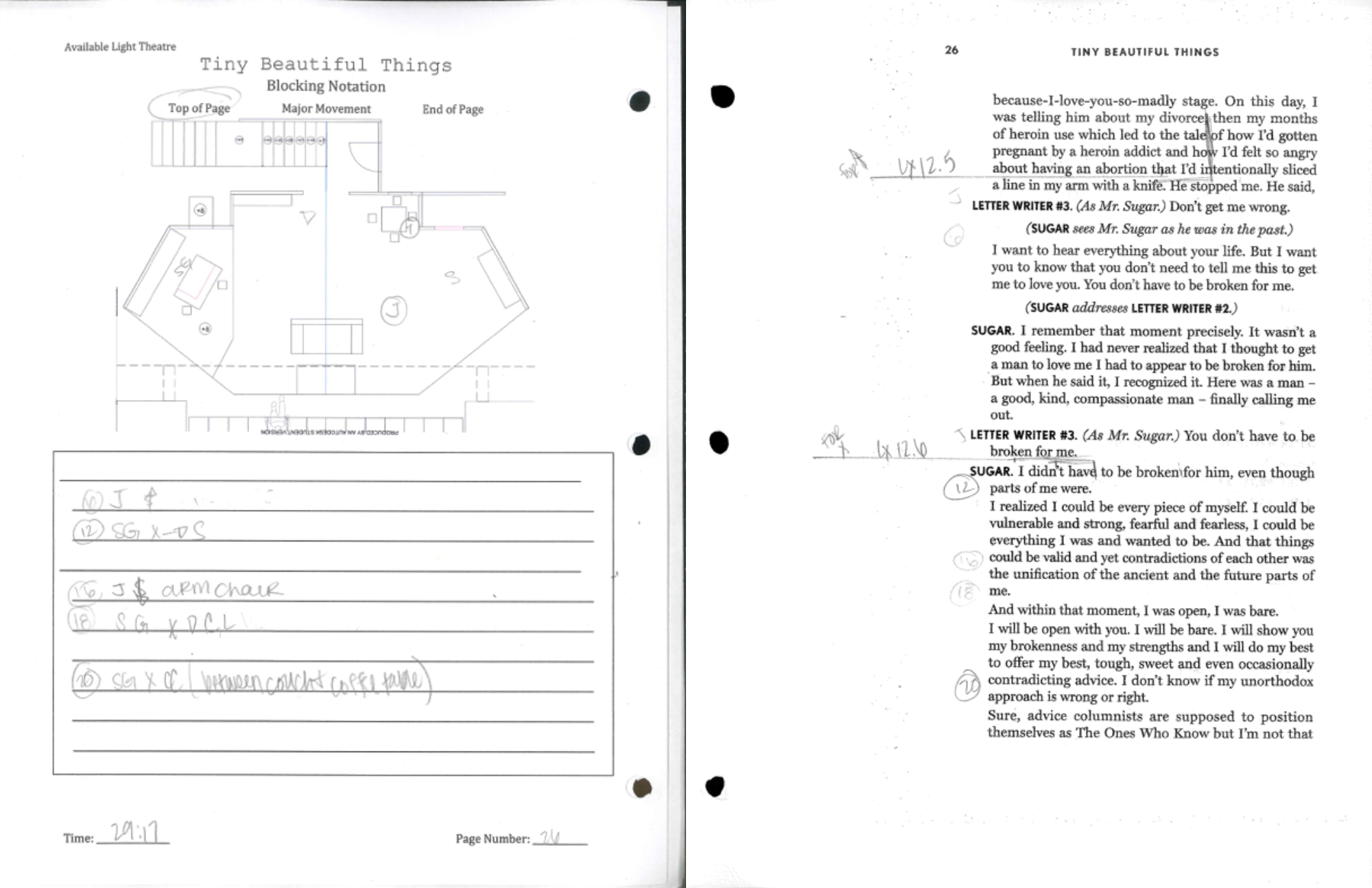How Stage Managers Record Blocking
/Much like last month’s article, I spent time at another state high school thespian festival—this time in Michigan. I dedicated much of my time to speaking with young stage managers and reviewing their work. While I saw a lot of excellent work, there was one area that stood out as needing improvement: blocking and call scripts, with a particular emphasis on blocking. At most festivals I attend, I offer a blocking notation workshop, so I thought it would be helpful to cover some of that material here.
This is an example i created using what I frequently see from high schoolers. This is page from the musical Head over Heels.
Here’s an example of what I typically see from high school stage managers. While some professional stage managers might use this format, to me and many others, it often appears sloppy and can be hard to follow. Blocking and cues inserted within the text can look visually cluttered and confusing.
To improve notation, there are a few simple adjustments we can make. The main one is the inclusion of blocking pages and a blocking key. These can be as simple or as detailed as you'd like, but the key point is that every page of the script should have a corresponding blocking page. This is usually done in advance, before rehearsals begin, so you have time to prepare.
Creating a Blocking Key
Some standard abbreviations. i give this same sample to my students.
A blocking key is a shorthand system you use to record movements and positions. For example, you might use "SL" for Stage Left and similar abbreviations for other areas of the stage. You can find many examples of blocking keys online, but I’ll include a sample one here as well. I also suggest creating shorthand for the characters in the show, typically using two letters to represent each character. For example, I might use “PH” for Philoclea. For large musicals with unnamed ensembles, I recommend using the performers' initials.
Blocking Pages
Your blocking page should have space for notes about the movements, and it can also feature an image (or several) of the ground plan. This allows you to draw arrows indicating complex movements. You can even number the notes to correspond with specific lines in the script to mark exactly where each action takes place. There are several ways to structure these pages, and the format is up to the stage manager. Personally, I prefer to have my script on the right side and my blocking sheet on the left (on the reverse side of the previous page). However, many stage managers prefer to have their blocking sheets on the opposite side. The important thing is to have a system that works for you, but also makes it easy for someone else to step in and understand your notation.
Below are two very basic templates that I use when teaching a blocking workshop.
Including a Mini Key
Something I’ve recently started doing is adding a mini key at the bottom of my blocking page to reference any special shorthand I’m using. This can also include shorthand for the characters, making it easy for me (or anyone stepping in for me) to quickly reference the notes. By having the most important notation information right on the blocking page, it’s easier for others to understand and follow.
Using Erasable Pens and Highlighters
Lately, I’ve been recording all of my blocking in an erasable pen. This allows me to make clean notes and color-code them. No more pencils smearing lead! I typically use these [https://amzn.to/3BVd5Xl] (affiliate link). For example, I typically write my blocking in black or blue ink and use another color (like green or purple) for special moments, such as fight choreography or intimate scenes. This method helps me quickly flip through my pages to find important notes.
A lot of younger stage managers like to highlight cues or specific moments in the script, and I recommend using erasable highlighters like [https://amzn.to/3PktaZE] (affiliate link). They’re particularly useful because, unlike most erasable highlighters, you can re-highlight after erasing. It’s important to do your research before purchasing to make sure they meet your needs.
The Takeaway
Take a look at my examples to see how much cleaner and more visually accessible blocking notes can be. I’m not saying these are perfect, but I would love to see more stage managers using this style. It’s a simple way to elevate your stage management book and make your work appear more polished.
I hope these tips were helpful! Feel free to reach out with any questions—I’m happy to help.
Wishing a Happy 2025 to stage managers everywhere!









